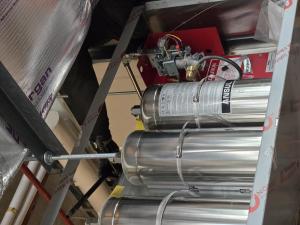FM-200 Clean Agent Fire Suppression Protects New York and South Florida’s Critical Infrastructure

A Ansul Fire Suppression System installed in a restaurant that Done Right Hood and Fire Safety Services Located in South Florida

Fire-safety professionals in New York City and South Florida point to FM-200 fire suppression systems for spaces where water isn't the solution.
BROOKLYN, NY, UNITED STATES, July 7, 2025 /EINPresswire.com/ -- Fire-safety professionals in New York City and South Florida point to FM-200™ (HFC-227ea) clean-agent systems as a proven solution for spaces where water would be catastrophic. Developed by DuPont (now Chemours) in the 1990s to replace ozone-depleting Halon, FM-200 is an odorless, colorless gas stored under pressure in sealed cylinders. When released, it extinguishes flames by rapidly absorbing heat and interrupting the combustion reaction. The discharge is fast – typically under 10 seconds – and, because FM-200 leaves no residue, there is minimal equipment damage or downtime after a fire. In fact, one manufacturer notes FM-200 “discharges as an electrically non‑conductive, clear vapor” and “leaves no residue and does not require costly clean up” unlike sprinklers or dry chemical systems. These qualities make FM-200 ideal for occupiable, mission-critical spaces where sensitive electronics, irreplaceable artwork or archival materials are kept.FM-200 first gained market acceptance in 1994 as an industry game-changer. Introduced by DuPont as an alternative to Halon 1301, FM-200 was one of the first clean agents approved for occupied areas. It is listed in NFPA 2001 as “HFC-227ea,” and international protocols have since phased down its production due to high global-warming potential. Nonetheless, FM-200 systems continue to protect billions in infrastructure. As one fire-safety specialist explains, FM-200 “doesn’t displace oxygen” when it floods a room, so occupants can safely evacuate while the agent snuffs the fire. By extinguishing flames through heat absorption (about 80% of its effect) and some chemical interruption (about 20%), FM-200 stops fires quickly without risking personnel. In short, the evolution from Halon to FM-200 created a safe, clean, and effective tool. And because FM-200 is electrically non-conductive, it was quickly adopted in industries that couldn’t tolerate water or debris – a trend that continues today as codes and insurance carriers embrace these “no-mess” systems.
An FM-200 system functions like a giant extinguisher tied into a fire alarm. Steel cylinders of liquid HFC-227ea are piped to nozzles in the protected area; when high-sensitivity smoke or heat detectors trigger the system, these cylinders discharge their contents as gas through the nozzle network. Because FM-200 absorbs heat, the local temperature plummets and the fire triangle is broken without reducing oxygen levels dangerously. The basic design follows NFPA 2001: cylinders (often double- or triple-walled) hold the agent under nitrogen pressure, and a control panel with horns, strobes and abort switches ensures safety and compliance. Practically speaking, everything must be tight – the protected room requires an integrity test (to ensure it holds pressure for at least 10 minutes), and the discharge pressure is balanced by symmetric piping so the gas spreads evenly. In New York, the FDNY mandates all FM-200 systems be designed per NFPA 2001, and technicians installing or servicing them must hold special certificates. As one NYC lead technician puts it, “This isn’t popcorn popcorn – when we set off an FM-200, we do it by the book. We got the smoke detectors, the horn and strobe, the abort key – everything in place. Then one shot of the agent shuts the fire before it spreads.”
Modern data centers, museums, broadcasting facilities and telecom switching stations are prime candidates for FM-200 protection. These environments are critical: a single water sprinkler leak in a server room can destroy arrays of hardware, and one wet napkin on a priceless archive might ruin generations of research. FM-200’s main advantages – fast flame knockdown and zero residue – directly address those risks. Industry sources note its common applications: banks, libraries, data centers, museums, and telecommunications centers. For example, an air-conditioned telecom vault jammed with fiber and circuit boards simply can’t risk a flooding sprinkler. An art conservator’s lab or a rare book wing can’t tolerate even a fine mist of water. FM-200 allows these spaces to remain highly protected without the collateral damage of wet systems. As Sal, a veteran technician with Done Right Hood and Fire Safety in Manhattan, explains: “When you got a server farm or a museum in the same building, FM-200 lets you douse the fire without touching the hardware or the paintings. We kick the flames out fast – no water, no residue – and that’s why our clients trust it. It’s reliable, and Done Right means we follow every rule from NFPA to FDNY.” Indeed, his team has installed FM-200 in downtown data centers and uptown galleries alike. He adds, “You can’t gamble with this stuff. FDNY has us on the hook for S‑16 and S‑61 Certificates of Fitness, so we study those NFPA 2001 protocols inside out. Then when it’s go time, one pull of the lever and FM‑200 gets the job done.”
Ansul FM-200 cylinders are engineered to store liquid HFC-227ea under high pressure for rapid discharge when needed. Working with FM-200 means working by many the book. In New York City, the Fire Code requires that all clean-agent systems meet NFPA standards and that certified personnel conduct every step. FDNY issues a special Certificate of Fitness (COF) for gaseous suppression: an S-16 COF for technicians who inspect, test or service the equipment, and an S-61 COF for the supervising principal or installer. In practice, an S-16 holder must be overseen by someone with an S-61, and both must be backed by a company with a Master Fire Suppression Contractor’s License (DOB Type A or C). These credentials ensure the techs are factory-trained on FM-200’s specifics, as the FDNY study guide emphasizes. In South Florida, similar rules apply: the state’s Fire Protection Contractor licensing (per Florida Statute 633) defines a Contractor III class that covers Halon and other chemical extinguishing systems. Only a licensed FPC can install or service FM-200 there, and all work must comply with NFPA 2001 and local fire codes. Done Right’s Florida manager Mike notes with a grin, “There's no shortcuts. We train every guy on the NFPA procedures, do all our inspections, and file the permits. When we say it’s under license and by the book, we mean it.” In both regions, these layers of code and certification exist because FM-200 is literally a life-safety system: wrong concentration or poor maintenance could fail to stop a fire. By contrast, when properly engineered and inspected, FM-200 meets strict UL/FM listings and EPA approvals for occupied spaces. As one manufacturer summary puts it, FM-200 “complies with the NFPA Standard 2001” and the EPA SNAP program, affirming its design for civilian use.
Several major companies dominate the clean-agent market, ensuring FM-200 technology is robust and widely supported. DuPont (now Chemours) remains the chemical supplier behind FM-200, while system integrators like Kidde (part of Carrier) and Ansul (Johnson Controls) engineer the cylinders, valves and nozzles to deliver it. Kidde’s product materials highlight FM-200’s safety: it is “non-ozone-depleting,” “safe for total flooding of occupied spaces,” and, again, “clean – no residue to clean up”. Ansul and its Pyro-Chem division also market FM-200 systems for high-value risks. Their literature notes FM-200’s advantages: it’s non‑toxic, electrically non‑conductive, and “unlike water… will not short‑out electronic equipment,” nor will its discharge chill circuitry like CO₂ systems do. In sum, firms like Kidde, Ansul and Fike supply turnkey FM-200 setups (cylinders, detection panels, piping) all designed to NFPA 2001 and UL/FM standards. Each cylinder is painted and labeled for compliance; for instance, Ansul’s FM-200 cylinders are UL-listed and factory-sealed to exacting tolerances. In recent years, environmental policy has led users to consider newer agents (like 3M™ Novec 1230 or inert mixtures), but FM-200 remains ubiquitous, especially in retrofit jobs. One clean-agent supplier notes FM-200’s phase-down under U.S. law, but emphasizes it’s still “widely accepted” for critical sites.
Through all these advances, one theme holds steady: FM-200 systems let facility managers meet fire-protection goals without sacrificing their equipment or exhibits. Whether defending a Florida telecom bunker or an NYC museum, Done Right Hood and Fire Safety technicians underscore the peace of mind FM-200 provides. As Mike sums up, “With FM-200 and the right credentials, we get businesses back online fast. There’s no mess, and the customers know we’ve followed every NFPA code. That’s how you do fire safety right.”
Gabriel Jean
Safety Group Corp.
+1 3474454880
email us here
Visit us on social media:
LinkedIn
Instagram
Facebook
YouTube
Legal Disclaimer:
EIN Presswire provides this news content "as is" without warranty of any kind. We do not accept any responsibility or liability for the accuracy, content, images, videos, licenses, completeness, legality, or reliability of the information contained in this article. If you have any complaints or copyright issues related to this article, kindly contact the author above.
Bridges that talk: GNSS reveals hidden structural shifts
Nafion Market to Reach USD 1,537.1 Million by 2035 | Key Players: The Chemours Company, DuPont, Solvay S.A., 3M
Transforming implant success: how gum tissue expert consensus may change dentistry
Więcej ważnych informacji
 Jedynka Newserii
Jedynka Newserii

 Jedynka Newserii
Jedynka Newserii

Konsument

Grupa nowych biednych emerytów stale się powiększa. Ich świadczenie jest znacznie poniżej minimalnej emerytury
Przybywa osób, które z powodu zbyt krótkiego czasu opłacania składek pobierają emeryturę niższą od minimalnej. Tak zwanych nowych biednych emerytów jest w Polsce ok. 430 tys., a zdecydowaną większość grupy stanowią kobiety – wskazują badania ekspertów Instytutu Pracy i Spraw Socjalnych. W ich przypadku krótszy okres składkowy zwykle wynika z konieczności opieki nad dziećmi lub innymi osobami w rodzinie. Wśród innych powodów, wymienianych zarówno przez panie, jak i panów, są także praca za granicą lub na czarno oraz zły stan zdrowia.
Media i PR
M. Wawrykiewicz (PO): Postępowanie z art. 7 przeciw Węgrom pokazało iluzoryczność tej sankcji. Unia wywiera naciski poprzez negocjacje nowego budżetu

Przykład Węgier pokazał, że procedura z artykułu 7 traktatu o UE o łamanie praworządności nie ma mocy prawnej z powodu braku większości, nie mówiąc o jednomyślności wśród pozostałych państw członkowskich. Negocjacje nowego budżetu UE to dobry pretekst do zmiany sposobu części finansowania z pominięciem rządu centralnego. Czerwcowy marsz Pride w Budapeszcie pokazał, że część społeczeństwa, głównie stolica, jest przeciwna rządom Viktora Orbána, ale i na prowincji świadomość konsekwencji działań Fideszu staje się coraz większa przed przyszłorocznymi wyborami.
Firma
Blockchain zmienia rynek pracy i edukacji. Poszukiwane są osoby posiadające wiedzę z różnych dziedzin

Zapotrzebowanie na specjalistów od technologii blockchain dynamicznie rośnie – nie tylko w obszarze IT, ale również w administracji, finansach czy logistyce. Coraz więcej uczelni wprowadza programy związane z rozproszonymi rejestrami, które wyposażają studentów w umiejętności odpowiadające wymogom rynku.
Partner serwisu
Szkolenia

Akademia Newserii
Akademia Newserii to projekt, w ramach którego najlepsi polscy dziennikarze biznesowi, giełdowi oraz lifestylowi, a także szkoleniowcy z wieloletnim doświadczeniem dzielą się swoją wiedzą nt. pracy z mediami.

![Nestlé w Polsce podsumowuje wpływ na krajową gospodarkę. Firma wygenerowała 0,6 proc. polskiego PKB [DEPESZA]](https://www.newseria.pl/files/1097841585/fabryka-nesquik_1,w_85,r_png,_small.png)






.gif)

 |
| |
| |
|